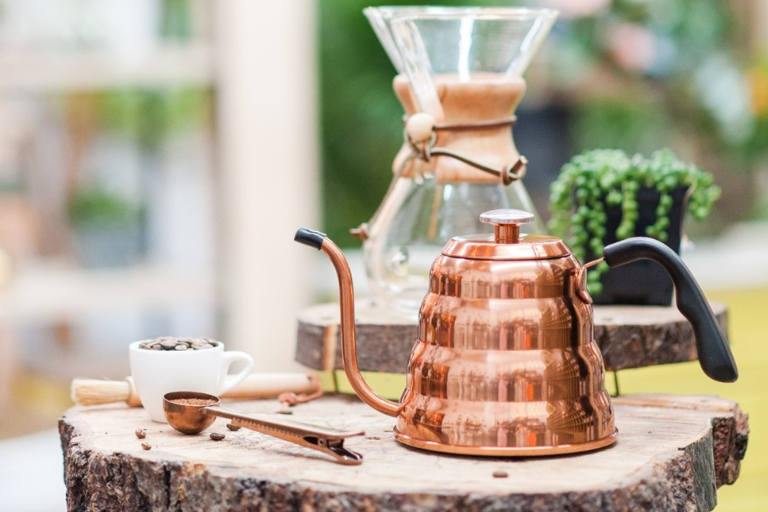Coffee Brewing: A Look at Some of the Most Popular Methods
By Tyler Workman

How many times this week have you brewed your coffee at home? Besides the traditional coffee maker (which is an American favorite), what other coffee-making gadgets do you have? Chances are that either you or your friends/family members have a coffee bar setup at home. From getting a coffee grinder, to buying a personal espresso machine, to even roasting coffee at home, coffee consumption has tremendously expanded over the last several years, and we are all connected to it in one way or another. In this month’s blog, I would like to explore the world of coffee brewing and provide some insight into how it has been evolving. Perhaps you are thinking that there isn’t much to talk about in terms of making coffee, but my hope is to show you how fascinating and diverse coffee is, and that there is a whole new world to be discovered regarding the art of coffee brewing.

Over the last decade, there has been an interesting move toward taking the knowledge and tools traditionally found only in coffee shops and placing them in the hands of us consumers, enabling the average person to have the ability to make coffee at home in a variety of exciting ways. The pandemic certainly accelerated this shift, pushing coffee drinkers to become self-made baristas as coffee needed to be brewed at home due to all the restrictions and closures.
This change has brought a new wave of coffee enthusiasts that not only enjoy making coffee at home, but also seek to learn how to improve their coffee skills by experimenting with different brewing methods, grinding their own coffee, and even using a scale to measure ratios. A segment of these enthusiasts has taken coffee brewing one step further; many of them now seek to compete on national and international stages, showcasing their coffee-brewing skills. This may sound crazy, but coffee brewing can get so technical and complex that there are opportunities for people to represent their countries at international venues and earn a chance to win world recognition and prizes, similar to athletes in the Olympic Games!
Below are a few of the ways people are brewing their coffee and a brief introduction to these unique methods.
Drip Method
This is by far the most common method in America and in many parts of the world. Hot water (although there are a few methods using cold water, too) drips over the ground coffee, extracting flavors over a certain amount of time while the ground coffee is retained by some type of filter (often a paper filter). The traditional coffee maker is part of the drip family, but devices such as the Chemex, Hario V60, and Melitta have become very popular pour-over options at home as well.

The idea behind a manual pour-over method is to have control over the extraction by regulating the water flow and the brewing time. Typically, a gooseneck kettle (a kettle designed specifically for manual pour-overs and featuring a long, curved spout), a timer, and a scale go hand-in-hand with pour-over devices, and although they keep you engaged throughout the whole brewing process, manual drips are a little more time consuming and involved than the traditional coffee maker.

One of the most world-renowned coffee competitions using the drip method is the World Brewers Cup. According to worldbrewerscup.org, this competition “highlights the craft of filter coffee brewing by hand,” where competitors from around the world have the opportunity to display their brewing skills in front of a panel of coffee-expert judges who score participants in the flavor of the cup, taste description, and customer service.

Immersion Method
This method is all about the ground coffee being in constant contact with water for a certain amount of time. Whether with hot or cold water, the purpose of an immersion method—much like steeping tea—is to extract the flavors while the coffee is fully immersed and then quickly filtrate the grounds. Some of the most popular immersion devices are the French press, cold brew pitchers, the Clever Dripper, and the AeroPress.

The AeroPress, created by Alan Adler, an inventor and retired Stanford University engineering professor, made its first appearance in the coffee scene in 2005 and quickly gained popularity among coffee brewers. It earned a spot in the international arena of coffee competitions in 2008 with the first World AeroPress Championship. The objective was simple: to find who could brew the best cup of AeroPress coffee. Since then, the competition has grown to cover 120 regional and national events taking place in over 60 countries and with more than 3,000 competitors who seek to claim the title of World AeroPress Champion.

Pressure Method
Although the concept of the pressure method is simple, the execution of it can be quite complex depending on the type of device you are using. The goal is to move water quickly through the coffee grounds by using pressure to achieve extraction in a very short amount of time. The most well-known pressure method device is the espresso machine, but single-serve pod machines (such as the Keurig) work in the same way and are very popular in American homes. In contrast, the Moka pot is not a well-known device in this category, but both single-serve pod machines and Moka pots are much easier to use than the espresso machine. However, home espresso machines are now gaining popularity.
Although not as affordable as most coffee brewing devices, home espresso machines can easily be found for the daily coffee drinker. From fully automatic machines to portable ones, there is a wide range to choose from. Chances are that you know someone who has a personal espresso machine at home, and I think that speaks to the advancement we have seen in recent years of making coffee brewing more accessible in our homes.

The World Barista Championship is an international competition that incorporates the preparation of espresso as one of the types of coffee drinks that competitors must present to the judges. The judges evaluate them on the taste of the drink as well as their cleanliness, creativity, technical skill, and overall presentation. Preparing an espresso shot requires careful calibration of the machine and all the other elements (e.g., coffee grind size, pressure), and as difficult as it already is, can you imagine having to do this in front of a panel of judges scoring your every move and with very specific time limitations? The level of skill that is demanded is why this competition seeks to advance the barista profession and honor the hard work of baristas across the globe.

As you can see, the ability to make coffee at home and in so many different ways has drastically transformed our relationship with coffee. Whether we are just brewing our morning coffee to enjoy at home or constantly rehearsing our skills and going over different techniques to improve our results, coffee brewing has a place for all of us. Time and time again, the world of coffee proves to be fascinating and diverse. I hope that this blog not only inspires you to have a deeper appreciation for the people who make our coffee, but also piques your interest in trying new ways to brew your coffee at home!


0 comments